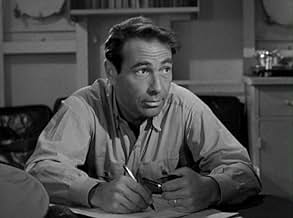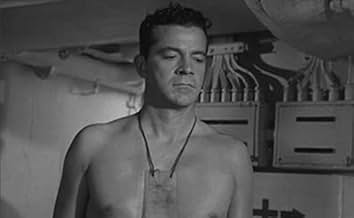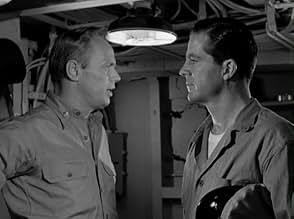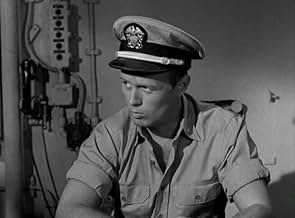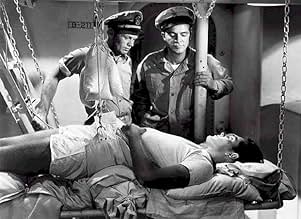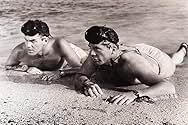IMDb RATING
6.5/10
1.6K
YOUR RATING
The new commander of a Navy Underwater Demolition Team--nicknamed "Frogmen"--must earn the respect of the men in his unit, who are still grieving over the death of their former commander and... Read allThe new commander of a Navy Underwater Demolition Team--nicknamed "Frogmen"--must earn the respect of the men in his unit, who are still grieving over the death of their former commander and resentful of the new one.The new commander of a Navy Underwater Demolition Team--nicknamed "Frogmen"--must earn the respect of the men in his unit, who are still grieving over the death of their former commander and resentful of the new one.
- Nominated for 2 Oscars
- 1 win & 3 nominations total
Robert Adler
- Chief Ryan
- (uncredited)
Parley Baer
- Dr. Ullman
- (uncredited)
William Bishop
- Ferrino
- (uncredited)
Frank Donahue
- Crew Member
- (uncredited)
Ed Donovan
- Crew Officer
- (uncredited)
Harry Flowers
- Kinsella
- (uncredited)
James Gregory
- Chief Petty Officer Lane
- (uncredited)
Harry Hamada
- Gunner
- (uncredited)
Featured reviews
The story in this one is nothing new-- the captain of an underwater demolition team (UDT) during WWII, who is a replacement to the previous beloved captain, must gain the respect of his men. The dialogue is at times a little hokey, and the performances are solid, but nothing stellar.
However, the project was obviously a heart-felt effort to capture, in detail, life aboard a WWII vessel, the procedures, the politics, and the rather fascinating methods and exploits of early UDTs, and that's what makes the film stand out. What you get is (I'm guessing) a pretty accurate representation of naval special forces in WWII, and it is quite interesting to watch how a team would covertly get in and out of shallow water near a beach to plant explosives and do recon, while being heavily shelled, often with nothing on them besides swim trunks, flippers and goggles! There are also a few very good, tense scenes. (the scene where their explosives expert has to disarm a torpedo with a tongue depressor is particularly nice-- expresses all the emotion and tension of such a moment without forcing it with a dramatic score).
Recommended to anyone interested in war history, or who enjoys a nicely crafted war movie.
However, the project was obviously a heart-felt effort to capture, in detail, life aboard a WWII vessel, the procedures, the politics, and the rather fascinating methods and exploits of early UDTs, and that's what makes the film stand out. What you get is (I'm guessing) a pretty accurate representation of naval special forces in WWII, and it is quite interesting to watch how a team would covertly get in and out of shallow water near a beach to plant explosives and do recon, while being heavily shelled, often with nothing on them besides swim trunks, flippers and goggles! There are also a few very good, tense scenes. (the scene where their explosives expert has to disarm a torpedo with a tongue depressor is particularly nice-- expresses all the emotion and tension of such a moment without forcing it with a dramatic score).
Recommended to anyone interested in war history, or who enjoys a nicely crafted war movie.
After watching and enjoying this film, I checked out the trivia section for this film and found that many of the events in this film are based on the real life unit they were named for in the film--including the banner on the beach scene. At first I thought this scene totally ridiculous and didn't fit the film--seeing it REALLY happened is amazing! This is an interesting war film even if it didn't get made until well after the war. Most people never think about the need for naval demolitions crews, yet their incredibly dangerous job is shown in this film. How dangerous it was and how they actually performed it was truly interesting for history buffs like myself. Seeing them often diving with no real equipment such as snorkels or tanks (these were only used late in the film) and simply free-diving to set demolition charges is pretty amazing. What was more amazing was seeing how they picked up these guys on the fly, so to speak.
Apart from the technical aspects of the film, the plot itself is somewhat formulaic but interesting. Richard Widmark plays the typical hard-as-nails commanding officer and naturally the men miss their old C.O. since he was "one of the boys" (see THE FLYING LEATHERNECKS and TWELVE O'CLOCK HIGH and you'll see what I mean). The whole "loneliness at the top" angle has been done many times before, though this one was played a bit better. Having such pros as Dana Andrews, Jeffrey Hunter and Gary Merrill on hand sure didn't hurt! What did hurt, however, with the formula was that, at times, it made the men seem like whiners.
Overall, rather exciting and well worth seeing despite its roots in Hollywood formula and a fitting tribute to some incredibly brave men.
Apart from the technical aspects of the film, the plot itself is somewhat formulaic but interesting. Richard Widmark plays the typical hard-as-nails commanding officer and naturally the men miss their old C.O. since he was "one of the boys" (see THE FLYING LEATHERNECKS and TWELVE O'CLOCK HIGH and you'll see what I mean). The whole "loneliness at the top" angle has been done many times before, though this one was played a bit better. Having such pros as Dana Andrews, Jeffrey Hunter and Gary Merrill on hand sure didn't hurt! What did hurt, however, with the formula was that, at times, it made the men seem like whiners.
Overall, rather exciting and well worth seeing despite its roots in Hollywood formula and a fitting tribute to some incredibly brave men.
The first time I saw this I was 10 years old, very impressionable and wanted very much to be like these men of war. This film has a lot to say about dedication and hard work learning the art of war. As John Wayne once said in "Sands of Iwo Jima" about the learning of the proper procedures of how to fight a war, because if we don't do it right a whole lot of men don't walk away from it, "forevermore they don't". As has been said this is the precursor to the modern day Seals. Sure I know they are tougher men today, but in my estimation not any more honorable and dedicated than the men portrayed in this "great" film.
The acting is outstanding and very real, especially to be so good that an old man like myself, remembers how I felt all the times I saw the film. If a film and the men involved in telling the tale of "The Frogmen" left that much impression and remembered to this day, then it had to be great acting, direction and favorably produced. There was no outlandish computer graphic techniques of today nor scenes of blowing up the world that come so common place in todays action genra films, but a reason and purpose for the gritty life and death struggle each man faced to become a frogman in the U. S. Navy or UDT (Underwater Demolition Teams) as they were and are called.
This black and white picture was dominated by the snarling Richard Widmark in perhaps his best performance in his career. I know many remember him for other films, but to me, he made this film and was the quintessential commander training his men to do a very difficult job with nothing more than shear strength of character and leadership. They did not have the high tech apparatus of todays Seals, but for what they lacked in equipment they more than made up for in "guts and glory" beneath the waters.
The rest of the cast, Dana Andrews, Gary Merrill, Jeffrey Hunter and Robert Wagner, just to name a few seemed to be portraying what is best in the Navy and men of war. Several more gave memorable performances in telling the tale of "The Frogmen" and the U. S. Navy's dedication to the finest in warfare.
The standard war movie is one thing, but this is a classic not seen much today and one in which many that followed learned by this tale of the U. S. Navy.
The acting is outstanding and very real, especially to be so good that an old man like myself, remembers how I felt all the times I saw the film. If a film and the men involved in telling the tale of "The Frogmen" left that much impression and remembered to this day, then it had to be great acting, direction and favorably produced. There was no outlandish computer graphic techniques of today nor scenes of blowing up the world that come so common place in todays action genra films, but a reason and purpose for the gritty life and death struggle each man faced to become a frogman in the U. S. Navy or UDT (Underwater Demolition Teams) as they were and are called.
This black and white picture was dominated by the snarling Richard Widmark in perhaps his best performance in his career. I know many remember him for other films, but to me, he made this film and was the quintessential commander training his men to do a very difficult job with nothing more than shear strength of character and leadership. They did not have the high tech apparatus of todays Seals, but for what they lacked in equipment they more than made up for in "guts and glory" beneath the waters.
The rest of the cast, Dana Andrews, Gary Merrill, Jeffrey Hunter and Robert Wagner, just to name a few seemed to be portraying what is best in the Navy and men of war. Several more gave memorable performances in telling the tale of "The Frogmen" and the U. S. Navy's dedication to the finest in warfare.
The standard war movie is one thing, but this is a classic not seen much today and one in which many that followed learned by this tale of the U. S. Navy.
The Frogmen is a film based on the exploits of the U.S. Navy's Underwater Demolition Teams during World War II. The primary task of these guys was to go in ahead of any island landing and clear away any obstacles put up by the enemy in the water. That meant going in ahead of the Marines as the Frogmen point out. Today that function is now that of the Navy Seals.
The plot is similar to Flying Leathernecks. Richard Widmark is the new commanding officer of the team assigned to Gary Merrill's ship and he's taking the place of a popular commander who was recently killed. He meets with a lot of resentment from the men, some of that resentment fueled by Dana Andrews who is the CPO of the team and very popular also with the crew. How Widmark and Andrews deal with their personal issues as well as get the job done is the basis of the film.
Nice underwater photography highlights the dangerous mission of these men. Both Widmark and Andrews despite their differences do get their assignments accomplished, not always in the most expeditious manner. These guys and their team are professionals in the real and the cinematic sense.
War films usually aren't chick flicks, but I have a sneaking suspicion that a lot of female fans saw this one for a glimpse of some 20th Century Fox's top young talent topless like Robert Wagner and Jeffrey Hunter.
Good an excuse as any to see a well made war film.
The plot is similar to Flying Leathernecks. Richard Widmark is the new commanding officer of the team assigned to Gary Merrill's ship and he's taking the place of a popular commander who was recently killed. He meets with a lot of resentment from the men, some of that resentment fueled by Dana Andrews who is the CPO of the team and very popular also with the crew. How Widmark and Andrews deal with their personal issues as well as get the job done is the basis of the film.
Nice underwater photography highlights the dangerous mission of these men. Both Widmark and Andrews despite their differences do get their assignments accomplished, not always in the most expeditious manner. These guys and their team are professionals in the real and the cinematic sense.
War films usually aren't chick flicks, but I have a sneaking suspicion that a lot of female fans saw this one for a glimpse of some 20th Century Fox's top young talent topless like Robert Wagner and Jeffrey Hunter.
Good an excuse as any to see a well made war film.
As would be the case with DESTINATION GOBI (1953), which I’ve just watched, this unusual war film about a specialized outfit also happens to be a starring vehicle for Richard Widmark (and, similarly, featured no prominent female roles). Fox were noted for the documentary-style approach to their films for the first few years of the post-war era; this was a typical example, mixing realistic detail (while the underwater photography in itself is well done, the film tends to drag during these sequences) with a number of established Hollywood conventions.
Widmark begins by rubbing his men the wrong way because of their devotion to his predecessor, with Dana Andrews as his chief antagonist (especially after the former opts to leave the latter behind during a reconnaissance operation). At one point, however, Andrews has to take over a mission when Widmark becomes indisposed (where the former’s lack of responsibility leads to serious injuries sustained by one of the men); eventually, the two acquire a mutual respect – which occurs when a torpedo fired at the ship by the enemy fails to explode and has to be delicately dismantled.
The latter sequence is one of four suspense/action set-pieces in the film: the others being the two underwater missions themselves and the trial run for the first operation mentioned above. The supporting cast is led by Gary Merrill (acting as, more or less, the voice of conscience) and Jeffrey Hunter (as a brash young member of the team); also appearing, in unbilled roles, are subsequent favorite character actors James Gregory and Jack Warden.
Widmark begins by rubbing his men the wrong way because of their devotion to his predecessor, with Dana Andrews as his chief antagonist (especially after the former opts to leave the latter behind during a reconnaissance operation). At one point, however, Andrews has to take over a mission when Widmark becomes indisposed (where the former’s lack of responsibility leads to serious injuries sustained by one of the men); eventually, the two acquire a mutual respect – which occurs when a torpedo fired at the ship by the enemy fails to explode and has to be delicately dismantled.
The latter sequence is one of four suspense/action set-pieces in the film: the others being the two underwater missions themselves and the trial run for the first operation mentioned above. The supporting cast is led by Gary Merrill (acting as, more or less, the voice of conscience) and Jeffrey Hunter (as a brash young member of the team); also appearing, in unbilled roles, are subsequent favorite character actors James Gregory and Jack Warden.
Did you know
- TriviaThe Underwater Demolition Team, the frogmen in the film, belong to is UDT-4 (some members of the team wear utility jackets with artwork of a large number "4" and a shark on the back). The real UDT-4 in World War II saw combat in the invasions of Okinawa, Saipan, Guam, and the Philippines. Like the fictional team in the film, the UDT-4 had one of their boats hit and sunk by Japanese fire at Leyte, and left a sign on the beach at Guam to welcome the invading Marines.
- GoofsThe triple-tank aqualungs used by the UDT frogmen during the film's climactic mission are incorrect for the WWII period. Although 'Jacques Cousteau', an officer in the French Navy, was working with experimental aqualungs near the end of WWII, U.S. Navy Underwater Demolition Teams did not have them during the war. Re-breathers, which had filters to trap carbon dioxide, were in use during this time period. Modern SEAL type units still use re-breathers because they produce no bubbles which can attract unwanted attention like they did in the movie. The Japanese divers in the movie had bubble-less re-breathers.
- Quotes
Lt. Cmdr. Pete Vincent: Looks like you've got what amounts to a legal mutiny on your hands.
- ConnectionsReferenced in Junior (1985)
- How long is The Frogmen?Powered by Alexa
Details
- Release date
- Country of origin
- Language
- Also known as
- Los que conmovieron el mar
- Filming locations
- Production company
- See more company credits at IMDbPro
- Runtime1 hour 36 minutes
- Color
- Aspect ratio
- 1.37 : 1
Contribute to this page
Suggest an edit or add missing content

Top Gap
By what name was Les hommes-grenouilles (1951) officially released in India in English?
Answer

